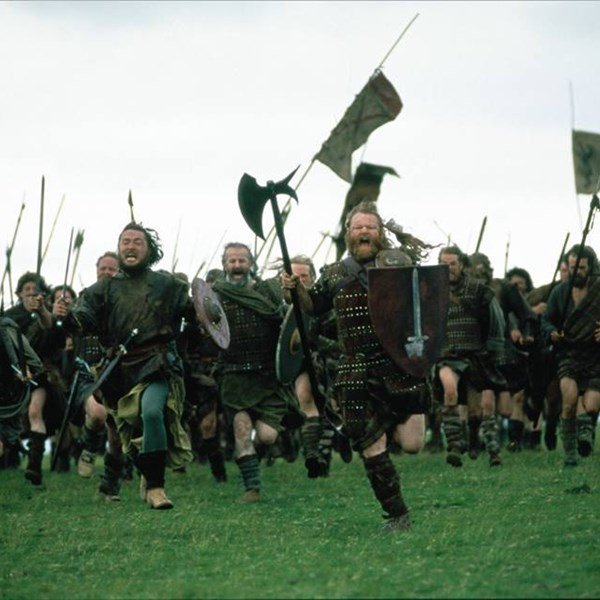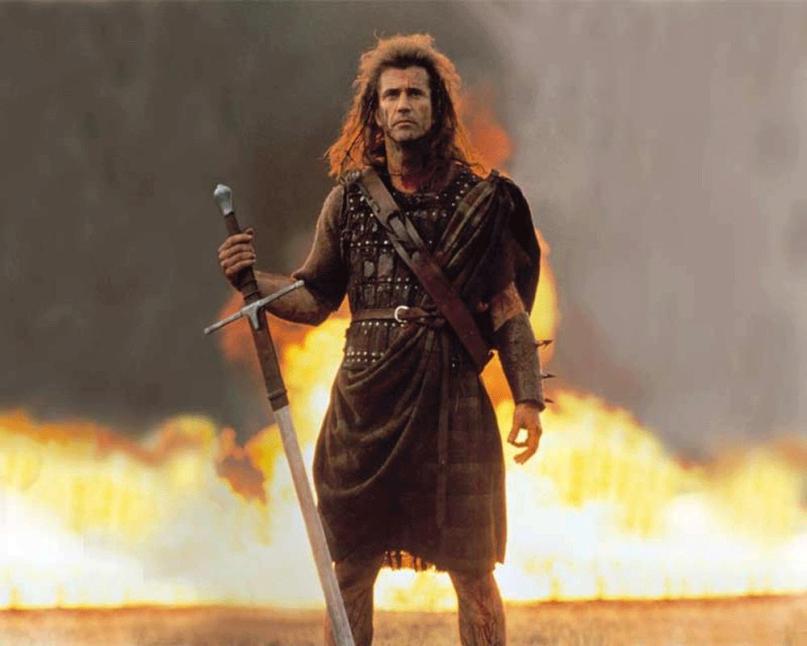Braveheart (1995)
CAST: Mel Gibson, Sophie Marceau, Catherine McCormack, Patrick McGoohan, Angus Macfadyen, Brendan Gleeson
REVIEW:
WARNING: THIS REVIEW WILL CONTAIN “SPOILERS”
For only his second outing behind the camera, Mel Gibson (who made his directorial debut in 1993’s The Man Without a Face, in which he also starred) has tackled the kind of ambitious undertaking Hollywood rarely mounts anymore, a grand epic throwback to the likes of Spartacus and Lawrence of Arabia. What might be more surprising is that he’s pulled it off in impressive fashion, showing he can handle a lavish production with large-scale battle scenes. In fact, among the directorial debuts or near-debuts of actors-turned-directors, it’s the most impressive entry since Kevin Costner’s Dances With Wolves five years earlier. Braveheart isn’t perfect, but it’s a rollicking, crowd-pleasing adventure painted on an epic scale with the kind of grandeur that might appeal to fans of Spartacus or The Last of the Mohicans.
There was a man named William Wallace, a Scottish rebel whose battles against the occupying English forces made him a national hero, but time has conflated fact with legend, and the movie isn’t strictly rooted in historical record. Wallace (Mel Gibson), orphaned as a child by the English, comes back home to woo Murran (Catherine McCormack) and seek a peaceful life as a farmer, staying out of the brewing English/Scottish conflict. But when the cruelty of the English occupation hits home, Wallace becomes a fierce rebel leader, drawing the support of rival clans assembling under one banner to answer the call of freedom. And as his victories ratchet up—first annihilating an armored and mounted English army at Stirling, then shockingly invading England itself and sacking York—he attracts the attention of the ruthless King Edward “Longshanks” (Patrick McGoohan), who seeks to destroy Wallace with both military force and political machinations. Meanwhile, Wallace also intrigues others, including Longshanks’ daughter-in-law, the French princess Isabella (Sophie Marceau) and Scottish aristocrat Robert “The Bruce” (Angus Macfadyen), who is torn between his admiration of Wallace and his noble allegiances.
From a historical standpoint, Braveheart freely takes large liberties. The real Queen Isabella was three years old and living in France at the time the movie portrays her as having an affair with Wallace, and the child that the movie baselessly implies to be Wallace’s, Edward III, was born seven years after Wallace’s death. Also, while Longshanks dying simultaneously with Wallace in the movie makes for a more cinematically satisfying ending, in reality he died two years after Wallace. The portrayal of the Battle of Stirling Bridge is highly inaccurate (as evidenced by the fact that it leaves out the bridge). Ultimately, these distortions rankle those concerned with historical accuracy in film, but will be of little consequence to casual mainstream moviegoers. Longshanks’ wimpy, foppish gay son Edward II (Peter Hanly) smacks of a homophobic caricature, and a scene in which Longshanks tosses his (implied) lover out the castle window, seemingly played for a dark laugh, leaves a bad taste. The movie paints in broad strokes—rugged Scotsmen versus foppish, sneering Englishmen whose portrayals at times verge on caricatures, led by the one-dimensionally evil, mustache-twirling Longshanks. In fairness, Robert the Bruce’s subplot injects a little more moral ambiguity, but here as well Braveheart rankles historians, adding an incident in which The Bruce betrays Wallace (an act there is no indication he ever committed), seemingly to set up The Bruce as a Scottish foil to Wallace for dramatic purposes, but at the cost of, in the eyes of many Scottish viewers, impugning the honor of The Bruce, who is regarded as significant a Scottish hero as Wallace himself. At least judging by his work here, spectacle and graphic bloodshed are Gibson’s directorial fortes more than subtlety or nuance.
 Much of the opening act centers around Wallace’s love for Murran, but in truth, while doing an effective job of setting up his motivation for rebellion, this is arguably the weakest part of the movie. We kick into gear when Murran’s unwarranted execution sparks the first flames of open rebellion, and Gibson doesn’t keep us waiting for a climactic battle royale. The movie has multiple “climaxes”, the first coming about midway with the Battle of Stirling Bridge which, while historically inaccurate, is the kind of large-scale battle scene seldom mounted, with thousands of extras and horses, and convincing blood and gore (a scene in which a cavalry charge of English horses run into a row of spears was so realistic that Gibson was investigated for animal cruelty before showing the mechanical horses constructed for the sequence). Gibson choreographs expertly enough to convey the chaos of battle without the audience themselves losing track of what’s happening or losing sight of the principal characters. There’s also political intrigue; Longshanks tries to buy the Scottish nobles off by throwing lands and titles at them, and their wishy-washiness makes them unreliable allies to Wallace.
Much of the opening act centers around Wallace’s love for Murran, but in truth, while doing an effective job of setting up his motivation for rebellion, this is arguably the weakest part of the movie. We kick into gear when Murran’s unwarranted execution sparks the first flames of open rebellion, and Gibson doesn’t keep us waiting for a climactic battle royale. The movie has multiple “climaxes”, the first coming about midway with the Battle of Stirling Bridge which, while historically inaccurate, is the kind of large-scale battle scene seldom mounted, with thousands of extras and horses, and convincing blood and gore (a scene in which a cavalry charge of English horses run into a row of spears was so realistic that Gibson was investigated for animal cruelty before showing the mechanical horses constructed for the sequence). Gibson choreographs expertly enough to convey the chaos of battle without the audience themselves losing track of what’s happening or losing sight of the principal characters. There’s also political intrigue; Longshanks tries to buy the Scottish nobles off by throwing lands and titles at them, and their wishy-washiness makes them unreliable allies to Wallace.
Mel Gibson’s achievement behind the camera is more impressive than his performance in front of it. Especially early on, he feels a little out-of-place, too lightweight, too modern, like Martin Riggs in a long-haired wig, a kilt, and a Scottish accent (which slips in and out a few times). Gibson is more effective when he gets to go into Mad Mel mode, ferociously hacking Englishmen to death and splattered with blood, than in his early breezy courtship scenes with Murran (Gibson did not originally intend to play Wallace, but Paramount Pictures only agreed to finance the film if Gibson played the lead). Catherine McCormack is effective as the catalyst for Wallace’s rebellion, and Sophie Marceau is gorgeous as his (historically dubious) secondary love interest. Patrick McGoohan does a little mustache-twirling as the cold, calculating Longshanks, Angus Macfadyen is the conflicted Robert the Bruce, Brendan Gleeson is Wallace’s faithful right-hand Hamish, and David O’Hara provides a smidgen of comic relief as the unhinged Irishman Stephen who joins their company. Smaller roles include various veteran UK actors like James Cosmo, Tommy Flanagan, Peter Mullan, John Kavanagh, Alun Armstrong, Gerard McSorley, Sean McGinley, and an almost unrecognizable Ian Bannen. There’s small parts for Michael Byrne (as a lecherous English soldier), and Brian Cox (who was also in the other Scottish movie of 1995, Rob Roy) as Wallace’s uncle Argyle.
Braveheart has flaws. It plays fast and loose with history (though some of its distortions and fabrications work effectively enough narratively), its authentic Scottishness is questionable (it was actually filmed in Ireland, and various cast members, including Mel Gibson, are non-Scots) and is more Hollywoodized than the grittier Rob Roy. The formidable three hour runtime also requires a sizable commitment of time and attention. But, for the most part, it overcomes its occasional unevenness by delivering enough sweeping action, drama, and romance to match its sizable ambitions. It’s a considerable filmmaking accomplishment, and an impressive demonstration that Mel Gibson’s talents do not only lie on one side of the camera.
* * * 1/2
